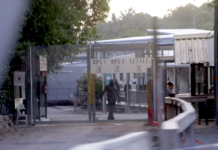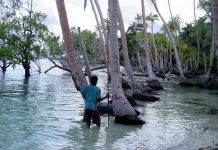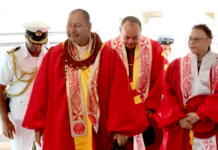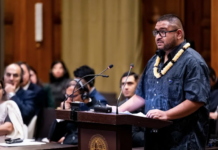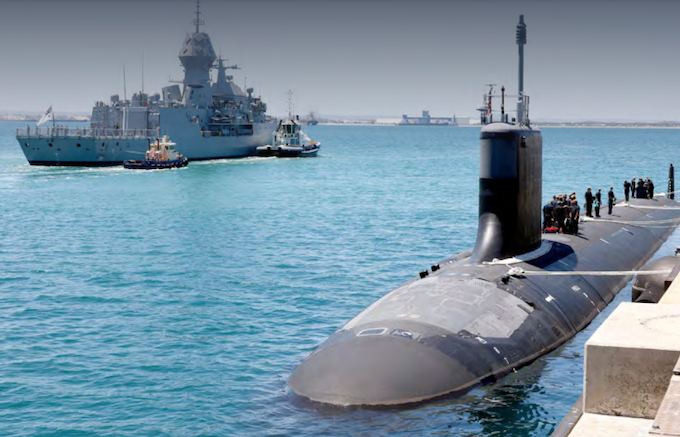
By Paul Gregoire in Sydney
One year since Prime Minister Anthony Albanese went to San Diego to unveil the AUKUS deal the news came that the first of three second-hand Virginia class nuclear-powered submarines supposed to arrive in 2032 may not happen.
Former coalition prime minister Scott Morrison announced AUKUS in September 2021 and Albanese continued to champion the pact between the US, Britain and Australia.
Phase one involves Australia acquiring eight nuclear-powered submarines as tensions in the Indo-Pacific are growing.
Concerns about the submarines ever materialising are not new, despite the US passing its National Defence Bill 2024 which facilitates the transfer of the nuclear-powered warships.
However, the Pentagon’s 2025 fiscal year budget only set aside funding to build one Virginia submarine. This affects the AUKUS deal as the US had promised to lift production from around 1.3 submarines a year to 2.3 to meet all requirements.
Australia’s acquisition of the first of three second-hand SSNs were to bridge the submarine gap, as talk about a US-led war on China continues.
US Democratic congressperson Joe Courtney told The Sydney Morning Herald on March 12 the US was struggling with its own shipbuilding capacity, meaning promises to Australia were being deprioritised.
Production downturn
Courtney said that the downturn in production “will remove one more attack submarine from a fleet that is already 17 submarines below the navy’s long-stated requirement of 66”.
The US needs to produce 18 more submarines by 2032 to be able to pass one on to Australia.
After passing laws permitting the transfer of nuclear technology, the deal is running a year at least behind schedule.
Greens Senator David Shoebridge said on X that “When the US passed the law to set up AUKUS they put in kill switches, one of which allowed the US to decide not [to] transfer the submarines if doing so would ‘degrade the US undersea capabilities’”.
Pat Conroy, Labor’s Defence Industry Minister, retorted that the government was confident the submarines would appear.
The White House seems unfazed; it would have been aware of the problems for some time.
Meanwhile the USS Annapolis, a US nuclear-powered submarine (SSN) has docked in Boorloo/Perth.
AUKUS still under way
Regardless of whether Australia acquires any nuclear-powered vessels, the rest of the AUKUS deal, including interoperability with the US, is already underway.
Andrew Hastie, Liberal Party spokesperson, confirmed that construction at HMAS Stirling will start next year for “Submarine Rotational Force-West (SRF-West)”, the permanent US-British nuclear-powered submarine base in WA, which is due to be completed in 2027.
SRF-West includes 700 US army personnel and their families being stationed in WA. If the second-hand nuclear submarines do not materialise, the US submarines will be on hand.
SRF-West may also serve as an alternative to the five British-designed AUKUS SSNs, slated to be built in Kaurna Yerta/Adelaide over coming decades.
Australia respects the Pentagon’s warhead ambiguity policy, meaning that any US military equipment stationed here could be carrying nuclear weapons: we will never know.
Shoebridge said on March 13 he was entering a hearing to decide where the AUKUS powers can dump their nuclear waste. Local waste dumps are being considered, as the US and Britain do not have permanent radioactive waste dumps.
The waste to be dumped is said to have a low-level radioactivity. However, as former Senator Rex Patrick pointed out, SSNs produce high-level radioactive waste at the end of their shelf lives that will need to be stored somewhere, underground, forever.
‘Radioactive waste management’
The Australian Naval Nuclear Power Safety Bill 2023, tabled last November, allows for the AUKUS SSNs to be constructed and also provides for “a radioactive waste management facility”.
The Australian public is spending US$3 billion on helping the US submarine industrial base expand capacity. An initial US$2 billion will be spent next year, followed by $100 million annually from 2026 through to 2033.
The Pentagon has budgeted US$4 billion for its submarine industry next year, with an extra US$11 billion over the following five years.
The removal of the Virginia subs, and even the AUKUS submarines from the agreement, would be in keeping with the terms of the 2014 Force Posture Agreement, signed off by then prime minister Tony Abbott.
As part of the Barack Obama administration’s 2011 “pivot to Asia”, the US-Australia Force Posture Agreement allows for 2500 Marines to be stationed in the Northern Territory.
It sets up increasing interoperability between both countries’ air forces and allows the US unimpeded access to dozens of “agreed-to facilities and areas”.
These agreed bases remain classified.
US takes full control
However, as the recent US overhaul of RAAF Base Tindall in the NT reveals, when the US decides to do that it takes full control.
Tindall has been upgraded to allow for six US B-52 bombers that may be carrying nuclear warheads.
US laws that facilitate the transfer of Virginia-class submarines also make clear that as Australia is now classified as a US domestic military source this allows the US privileged access to critical minerals, such as lithium.
Paul Gregoire writes for Sydney Criminal Lawyers where a version of this article was first published. The article has also been published at Green Left magazine and is republished with permission.




